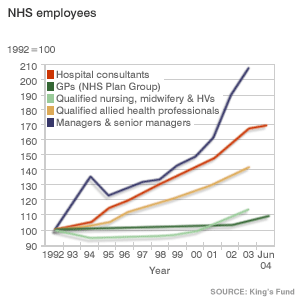Which flow chart do you want?

Lumo (physicist Luboš Motl from Pilsen Czech Republic) welcomes America to the EU today with an animated flow chart of the healthcare system in the United States.
It was created as a simplified visual of the healthcare reforms being proposed, perhaps as a last effort to get American’s to think about the reality of the bureaucratic monster that’s been created. Each agency created to oversee some aspect of “quality” comes with another long set of regulations that needs another agency to oversee compliance… and on and on. Behind every quality measure and every reform being proposed, of course, is a special interest that lobbied hard for it. Reform doesn't appear to really be addressing what needs fixing. [Click here for larger image.]

When have bureaucracies proven more efficient and to save money? With cable or telephone service, most people understand the idea that monopolies and government mandates raise costs, eliminate competition, reduce choice, and create shortages. Somehow that insight goes out the window when it comes to healthcare. Why are people so ready to believe that any third party knows best and will make the soundest decisions on their behalf — and believe that such decisions will be objective and free from the influence of special interests? Why are people so ready to believe that they need a massive bureaucratic network to come between them and their doctor? Worse, how can anyone believe that such a system will save money, make things more efficient and make health care better? Like Canada, perhaps? [Addendum: Seriously, the facts of Canadian healthcare from medical professionals have been extensively covered, for example here.]
Imagine the savings of a flow chart that looks like this:
Doctor ————> Patient
Medical professionals in Europe have been writing impassioned articles for years, urging Americans to investigate the realities of turning over their healthcare decisions and oversight to the government. They’ve revealed the costs they’ve seen to access and quality of care for patients, sacrifices to research, and growing severe shortages of providers and resources, while the govenrment bureaucracy grows larger. Rather than government guidelines being evidence-based, as we’ve seen with the National Institute for Health and Clinical Excellence (NICE) as well as here, they’re rife with bad science and special interests.
Sadly, consumers rarely read or hear about the medical literature or understand the concerns medical professionals are talking about and experiencing. One of the most popularized beliefs among laypeople in the U.S. is that a government-run healthcare system would be more efficient, with less bureaucracy and waste. What is the evidence for such a belief?
There is none. The available evidence points to the opposite. The National Health Service, for instance, has seen skyrocketing growth in administrators and consultants since 1992, while little growth in the number of professional doctors and nurses actually providing the care.

But none of this is about the evidence or even very reasoned, is it?




<< Home